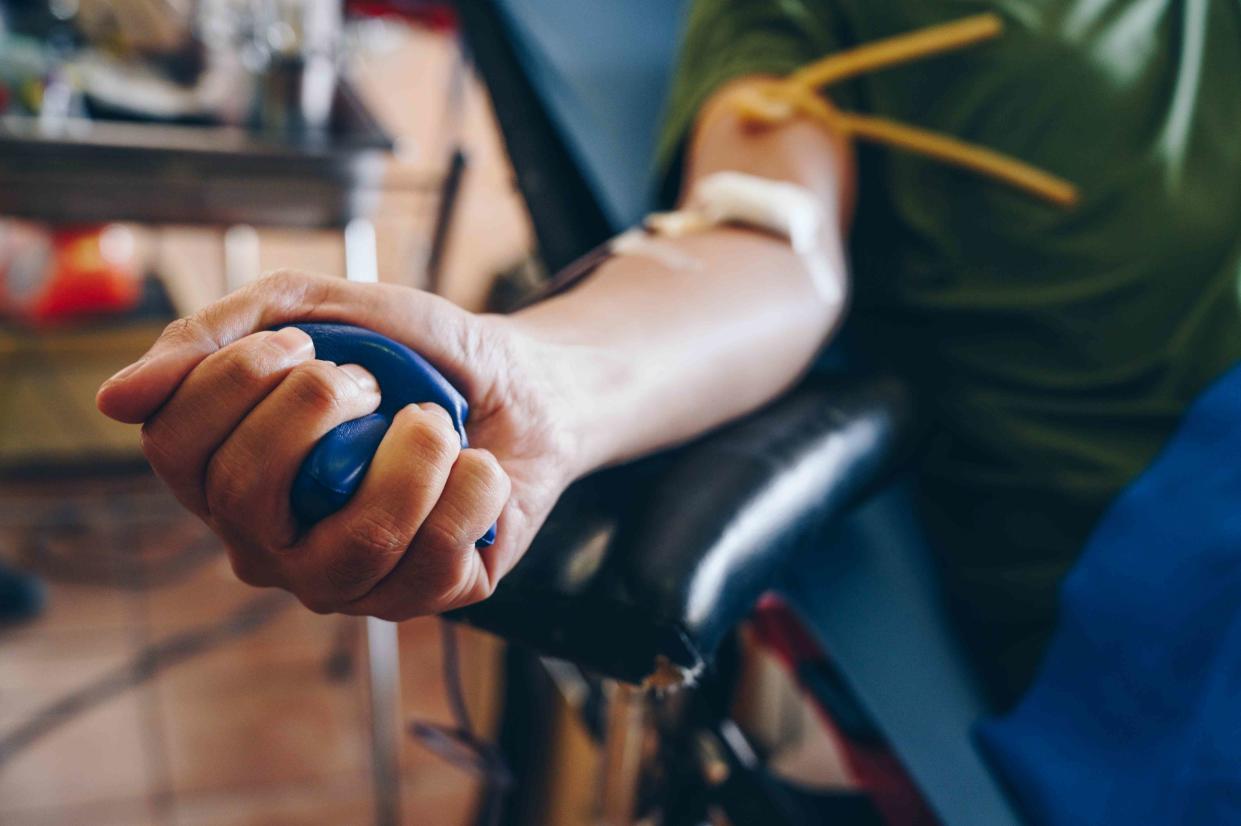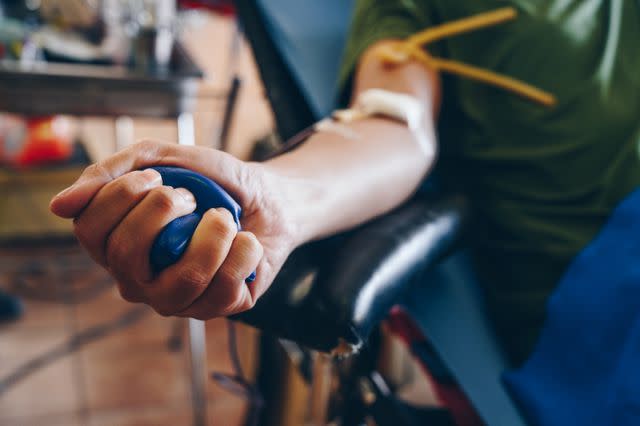FDA Blood Donation Guidelines: New Update Will Allow More Gay, Bisexual Men to Donate

Boy_Anupong/Getty Images
Fact checked by Nick Blackmer
The FDA is implementing an individual risk assessment approach to blood donations, which means that more gay and bisexual men will be now allowed to donate blood.
Prior to these changes, this group had to follow special guidelines before donating blood due to concerns over HIV infections, but many protested the rules as discriminatory.
The guidelines are likely being updated thanks to new data and improved blood screening, experts say, and may substantially increase the U.S. blood supply.

Boy_Anupong/Getty Images
The Food and Drug Administration (FDA) has implemented new guidance for blood donation, which will allow more gay and bisexual men to donate blood, the agency announced last week.
The updated recommendations, first proposed in January, move the U.S. to an individual risk assessment model for blood donation, meaning that men who have sex with men (MSM) will not be subjected to extra requirements or ineligibility if they are not considered to be high-risk donors.
Gay and bisexual men were considered ineligible to give blood starting in 1985 due to the MSM community’s higher risk of human immunodeficiency virus (HIV). In 2015, the total ban was eliminated and MSM were allowed to donate blood if they abstained from sex for one year. Starting in 2020, this requirement was lowered to abstinence from sex for three months.
But groups have long advocated for the end of these sexual-orientation and gender-specific requirements for blood donation, saying they’re discriminatory.
The new individual risk assessment guidelines no longer single out gay and bisexual men or women who have sex with them. Instead, all interested donors will have to answer the same set of questions.
A person’s sexual activity or other behaviors could still disqualify them from giving blood, however, because they’re deemed at higher risk of HIV. Among other qualifications, having a new sexual partner or multiple sexual partners in the last three months, and having anal sex in the past three months would make someone “deferred,” or ineligible to donate blood for the time being.
These updated guidelines bring the U.S. in line with other countries such as the U.K. and Canada, and will likely increase the amount of donated blood, experts say.
“They’ve changed the policy in a way that protects the safety and security of the blood supply, but allows more people to donate blood, which will increase the volume, the quantity of units of blood available,” Sean Cahill, PhD, director of health policy research at the Fenway Institute, told Health.
Here’s what experts had to say about how guidelines keep the blood supply safe, why the guidelines are being changed now, and what this means for the future of blood donation in the U.S.
Making Sure Blood Transfusions Are Safe
The guidelines are a safeguard for the U.S. blood supply—the FDA wants to avoid any possible situations in which a person receiving blood acquires HIV or another bloodborne disease from the blood they’re given.
MSM are disproportionately at risk for HIV—the lifetime risk for HIV in the MSM community is one in six; that’s compared to a one in 524 lifetime risk for heterosexual men and a one in 253 lifetime risk for heterosexual women. Left untreated, HIV can lead to acquired immunodeficiency syndrome (AIDS).
The original blood donation ban for gay and bisexual men came in response to an issue in the 1980s, during which blood recipients were infected with HIV.
“There was a situation where a number of units of blood that had HIV were given to people as blood transfusions or in blood products. And roughly 10,000 people with hemophilia were infected with HIV,” Cahill said. “The FDA, since then, has really been trying to prevent a repeat of that from happening.”
But because not all MSM have HIV, many have criticized the total ban on blood donation based on sexual orientation.
These most recently updated guidelines are meant to make the criteria fairer, and still protect the blood supply while not excluding people unnecessarily, experts agreed.
The new language in the questions is gender neutral, Cahill explained, and allows gay or bisexual men who are in monogamous relationships or aren’t having anal sex to donate blood.
People can be considered ineligible or may have to defer their donation if they have:
Had a positive test or have been treated for HIV
Taken pre-exposure prophylaxis (PrEP) for HIV prevention
Had a new partner or multiple sexual partners and had anal sex in the last three months
Exchanged sex for a form of payment in the last three months
Used non-prescription injection drugs in the last three months
Had sexual contact with someone who tested positive for HIV
Gotten certain tattoos, or ear or body piercings
Related:7 Major Health Disparities Affecting the LGBTQ+ Community
Why Make the Changes Now?
Though the FDA has been steadily rolling back restrictions on MSM donating blood since 2015, criticism of these bans and deferrals have been widespread for many years.
“Whenever somebody says you’re relaxing restrictions, it makes people nervous. But this wasn’t something that [the] FDA or scientists woke up last week and decided to do,” Art Caplan, PhD, founding head of the Division of Medical Ethics at the NYU Grossman School of Medicine, told Health.
The change is simply putting recommendations more in line with current evidence, Caplan added.
When making the change, the FDA said it reviewed data from other countries that had individual risk assessment guidelines for blood donations, as well as other data, such as the ADVANCE study.
Preliminary results from this study found that, among sexually-active MSM, there are a significant portion that meet the criteria of having no new sexual partners and only one partner. This group is also likely at a lower risk of HIV, which means that these questions do a good job of keeping the donated blood supply safe.
“That trial just completed recently, and I think it’s in response to that new data that the FDA has taken this move,” Cahill said.
In addition, over the years people have come to trust screening technology more, Caplan said. Routine testing after blood is donated would likely pick up any bloodborne pathogens before it’s given to patients.
And though the FDA’s decision is still an evidence-based one, it’s also true that pressure from more frequent blood shortages could have provided an extra incentive for the organization to finally make these changes.
“We’re getting short on blood supply,” Caplan said. “It’s not insignificant that you’d rather have blood and take some small additional risks than have no blood.”
Related:4 Health Benefits of Blood Donation
Implementing New Guidelines
As of last week, blood banks were able to start amending their questions to put the guidelines into effect, the FDA said. The agency will work closely with these groups to “ensure timely implementation of the new recommendations,” Peter Marks, MD, PhD, director of the FDA’s Center for Biologics Evaluation and Research, said in a press release.
But logistically speaking, it may be a while before blood donors notice a difference.
For organizations such as Vitalant, a nonprofit blood donation organization, it will take some time to make these changes, Nick Gehrig, senior director of communications for Vitalant, told Health.
“Vitalant is preparing for the extensive process of updating donation materials and computer systems, and training about 1,500 staff members,” the company’s press release said. “We will complete the transition as quickly as possible while ensuring compliance with the final guidance.”
Once the questionnaires are fully updated, people should obviously still expect to have to answer personal questions about their medical and sexual history. But people can expect “a more sophisticated line of questioning that really pinpoints risk behavior,” Caplan said.
The ruling gets rid of the pointed stigma against MSM, but it’s not yet clear how these changes will affect the U.S. blood supply.
There will be a fair number of people who still won’t be able to give blood—or, they may have to wait—because of their sexual behavior or drug use. For example, the CDC estimates that about 300,000 people have been prescribed PrEP, which also makes them ineligible for blood donation.
On top of that, currently just 3% of people who are eligible donate blood, so it’s hard to know how many many gay and bisexual men will be interested in donating.
But it could have a large impact, Cahill said. A 2014 report found that if a ban on MSM blood donations were to be lifted, the U.S. could see an additional 345,000 to 615,000 pints of blood donated annually.
People who were possibly boycotting blood donation or had a negative opinion of it may also be more inclined to give blood now that the rules have changed, Cahill added.
And besides the benefit of more inclusive and accurate guidelines, the FDA’s announcement is also a good reminder to everyone to donate blood, Caplan added.
“The need for blood continues to grow and we are teetering on the edge of not having enough,” Caplan said. “It’s kind of like water or oil—you can’t run a health system without blood and blood products. So it’s very crucial that we not wind up with an inadequate supply.”
For more Health news, make sure to sign up for our newsletter!
Read the original article on Health.

